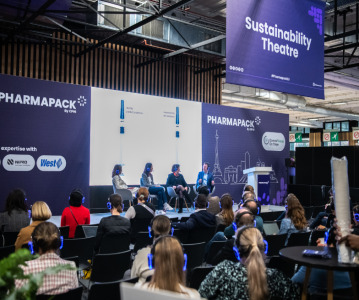Women in Pharma: Marketing for the other half in healthcare

In our new monthly series, we interview women from across the pharmaceutical industry and supply chain to discuss the importance of gender diversity in healthcare, the workplace, and beyond. This instalment highlights not only the importance of marketing in the pharmaceutical supply chain, but also how to shift towards a market that is becoming increasingly gender inclusive.
We speak with Sanobar Syed, Business Strategy and Commercial Expert, on how companies can genuinely engage with both the women in their organisations as well as in the consumer market.
1. Can you please introduce yourself and your role?
My name is Sanobar Syed, and I have around 15 years of experience in leading business strategy and forecasting for very reputable pharmaceutical companies across the globe. I’m an industry expert who works along with top pharma firms and I’m involved in bridging the gap between academia and industry. My major areas of expertise are global strategy, analytics, and forecasting – I really focus on emerging trends within the pharmaceutical (innovator and generics) and their usage in real life I’ve lived and travelled across the globe, and am an expert in the APAC, US, Canadian, and European markets. I think a part of that was being intentional in my career – I continuously evolve in different geographies and that is my unique selling point.
2. How has marketing, whether B2B or B2C, within the pharmaceutical supply chain evolved over the last decade?
I think I’m very fortunate to be a part of this journey with sector involvement. Not a lot of times does the individual and the sector grow in parallel. Just to give you an anecdote – I'm a millennial. When I started working, there was a lot of digitalisation and a lot of technology was coming in. I’m very fortunate to have grown with this. When I started my career long ago, the supply chain at that time was very order-driven and essentially more reactive than proactive. That is what I saw in my early career. When I grew in my role, I worked with major billion-dollar pharma firms I saw how much digitalisation was being introduced. Starting with a very humble SAP system to predictive modelling on-demand and forecasting of the supply chain, I’ve seen it evolve. Another facet I want to highlight is not only how pharmaceutical companies have evolved, but also allied industries such as transportation, reagents, excipients etc. I still recollect using data loggers – we had temperature-controlled shipments and we had data loggers that used to have a manual reading, and it would only get the record once the flight has landed and somebody logged it manually. But now it’s all real-time, and you can track and get the report almost instantly. A lot of these technological advanced have occurred in this space in the last decade, which is a huge growth. However, pharmaceuticals (moreover generics or nutraceuticals space) still have a bit of catching up to do in terms of technology acceptance. CPG firms typically jump at new technology. We are the conservative cousins of consumer industries and so we wait. But after COVID, I think things really started picking up. I would say in summary, if I look just 10 years back, there’s a huge technology jump and acceptance in the industry and I feel that this is going to not only make pharma companies and supply chains more resilient and I think it is really important to understand and accept that disruptions have become commonplace, especially as the pharma supply chain is becoming more global, more complex, and seeing a lot more outsourcing and perhaps reshoring, with new modalities and ways of reaching patients with new technologies.
At the end of the day, what we are trying to achieve is that end-to-end transparency because there are so many different companies in the supply chain. We are really looking to have that stress test and reassessment and reduce the exposure to surprises and shocks. That is why one of the ways is to create a risk committee, understanding how we can make the supply chain a unit vs considering it as an offshoot activity. You really want to integrate that into the system.
3. Why is it important for pharmaceutical companies and service providers to consider gender inclusivity when developing marketing campaigns and advertising strategies? Do consumer trends play a part in these campaigns?
I know gender inclusivity is now a buzzword but I truly believe that the reason why it’s a buzzword is that the world is waking up to the fact that you can’t leave 50% of the population behind. In my experience of leading DEI with premier organisations I have seen that there can be so many layers of inclusion. It depends on how you define inclusivity – I think oftentimes it can manifest from personal beliefs. It all comes from our background, our training etc., so there’s lightyears of work to be done in this space now.
The good news is that there are organisations that are starting to do this. They are embracing this as a part of their ESG structure. Having said that, there is still a lot of work to be done. You don’t want tokenism. You don’t want to be performative. Why it is important is that, according to the Harvard Business Review, the market that women represent is bigger than China and India combined, which is a crazy big number. They control about $20 trillion in consumer spending, and the figure could reach around £28 trillion in the next 5 years. Essentially, women drive the world economy, yet companies do a remarkable poor job of serving them. Coming back to the supply chain, we need to understand that women are the most powerful consumers and that there is a gender gap between them and the leadership of companies that manufacture, market, and sell to them.
There are three ways which I have seen are best practices. The first is walking the talk – continuously increasing the representation of women, and I would even add people of colour, within all levels and teams around the world is important, while also giving merit importance. The second is how you as a company in the supply chain exercise influence on who your partners are, consciously identifying and giving incentives to such businesses owned by minority populations, women, people of colour etc. The third I want to include is that diversity and inclusion begins at home. That means you will need to have those teams or panels making decisions and giving them proper tools and resources for inclusive leadership, as well as education about racism and having empathetic conversations about diversity, equity, and inclusion.
4. How does considering healthcare from a female perspective affect the marketing strategies of pharmaceutical players to meet consumer demands?
We have to understand that from a healthcare perspective, for example for an OTC manufacturer for cold and cough, how many women are traditionally the caregivers for their families, even in today’s era. In the generics industry, two APIs that are the same might have two different brands. Which brand I pick will depend on how that brand appeals and identifies to me and depends on how the brand has been marketed to me. It’s really grassroots – women are passive consumers. You don’t have to make an outrightly pink colour campaign to get women on board, but you really need to understand that there will be a woman somewhere in the purchase.
For something like an oncology drug, or prescription drugs for serious disease indications, that’s a very doctor-driven decision. If you have a patient affected by cancer or Parkinson’s, the family will also be affected. With a woman as a traditional caregiver, how can you show support for the patient – for example, some of these drugs have patient support programmes or mental health programmes for women. In geographies like the US, this can be applicable. I’m not sure in a developing country if this will be possible outright, but in a developing country, this may be an impactful decision driver.
At the end of the day, whether it is an OTC drug or prescription, there’s certainly avenues to be reaching out to women, and pharma companies need to go beyond just warming up to this idea.
5. Establishing a digital marketing presence is a hugely important part of the pharmaceutical marketeer’s arsenal of tools. How can the pharmaceutical market develop unique experiences for female audiences in their digital campaigns?
A huge portion of doctors are still very traditional with paper-based approaches. A lot of doctors in other geographies might be very developed in the adoption of digitalisation but some others might not be. There is a huge shift after COVID because pharma companies woke up and were like “Whoa we need to do something digital as we cannot visit the doctors face to face”. So now, digital channels are really being pushed but we do have digital constraints. It is important that when you design a pharma campaign to look at the audience and doctor profile. I haven’t seen a lot of such persona profiling unless it is a female or gynaecological product. One of the major objectives should also be an omnichannel presence. You want to make sure you have the tools to provide a balanced and unique experience to your audience of women.
There’s still a long way to go in achieving customer centricity – trying to strike a balance between conversation and interactions while staying away from digital fatigue. Things will rapidly change but I do want to bring up, in terms of digital and omnichannel, that we have become data-rich, insight-poor (DRIP). There’s so much data from so many resources but we don’t have insights. You need the insights to feed into your strategy for revenues and resourcing. It’s a cycle – you need to make sure that the insights are being fed, not just the data.
6. How can pharmaceutical companies and supply chain players authentically engage with gender-based marketing?
There is a report from the International Labour Organisation talking about women in global supply chains. There are 190 million women in global supply chains. A lot of these jobs are concentrated in areas where international labour standards are poorly implemented. There’s precarious work timing, occupational segregation, poor access to maternity rights and childcare, long working hours, harassment etc. The gender gap in the supply chain can reach up to 30–50%. What is really important is how we can mitigate and adopt policies that provide equal opportunities in employment and promote social dialogue and collective bargaining – for example, supporting business partners or supply chains driving towards equal pay for equal work.
What also needs to be adopted is very strict, zero-tolerance attitude towards violence and harassment. There must be guidance and training/awareness available. What we can do as pharma companies is have business partnerships where, just as much as we ask about your APIs or XRD results or practical results from a technical question, we ask about social and behavioural equity practices amongst our business partners, contractors, and suppliers. If we have the tough conversations today, trust me, this will be the norm and future.
Related News
-
News A Day in the Life of Oncology Start-Up Co-Founder & CEO
This Women's month we are highlighting stories of women in the pharma industry (building on what we do every month to support women), so for the Day in the Life of we are speaking to Sharon Cunningham who is the Co-founder and CEO of Shorla On... -
News Women in Pharma: Manufacturing personal and team success
Our monthly Women in Pharma series highlights the influential lives and works of impactful women working across the pharmaceutical industry, and how the industry can work towards making the healthcare industry and workplace more equitable and inclusive... -
News Women in Pharma: Connecting accessible pharma packaging to patients – a Pharmapack Special
Throughout our Women in Pharma series, we aim to highlight how CPHI events encourage discussions around diversity, equity, and inclusion initiatives in the pharmaceutical industry. -
News Women in Pharma: Delivering on global access to medicines
Our monthly Women in Pharma series highlights the influential lives and works of impactful women working across the pharmaceutical industry, and how the industry can work towards making the healthcare industry and workplace more equitable and inclusive... -
News Women in Pharma: Our hopes for 2025 and beyond
Our last instalment for 2024 of the Women in Pharma series brings you messages direct from the Informa Markets CPHI team as they discuss the advice and insights they have carried throughout their roles working at CPHI, and what they hope to see for the... -
News Closing 2024 with Editors' picks of top articles from the past year
Coming to the end of 2024 and it’s certainly been a busy year, for CPHI and for the rest of the pharmaceutical and healthcare industry. Topics of conversation throughout the last 12 months have been varied, touching on the technical, to the polit... -
News Day in the Life of a Green Chief Financial Officer
Our latest look into the daily lives of the people behind the pharma community brings us to meet Juan Jose Piedra Galan, Global Financial Planning & Analysis Manager for Galderma, otherwise known as 'The Green CFO'. -
News Women in Pharma: Reflections from Behind the Scenes
In this instalment of our monthly series, the team that brings you the Women in Pharma series each month sits down for a heart-to-heart on what the series means to them, and how they hope to continue their work in the future.
Recently Visited
Position your company at the heart of the global Pharma industry with a CPHI Online membership
-
Your products and solutions visible to thousands of visitors within the largest Pharma marketplace
-
Generate high-quality, engaged leads for your business, all year round
-
Promote your business as the industry’s thought-leader by hosting your reports, brochures and videos within your profile
-
Your company’s profile boosted at all participating CPHI events
-
An easy-to-use platform with a detailed dashboard showing your leads and performance





.png)


